Are you a real retro gaming nut? Do you spend ages playing on emulators, or do you insist on the real thing? Not sure what all this retro fuss is all about? Well this could be the right place. CGEUK brings together gaming from the 1970’s, 80’s and 90’s in a unique hands on event, run over a whole weekend. Whether you love Atari, Sega, Nintendo, BBCs, PCs or the real arcade experience, they say they have the lot. Meet special guests who shaped the way for gaming today such as Jeff Minter, Matthew Smith, Archer Maclean, Andy Nuttall and some other “Bullfrog” staff, and a few staff from “Ocean Software.” Play pinball, arcade classics, MAME and consoles til your thumbs ache. Fairfield Halls, Croydon, London http://www.cgeuk.com/
Digital-Lifestyles pre-empted and reported thousands of articles on the then-coming impact that technology was to have on all forms of Media. Launched in 2001 as a research blog to aid its founder, Simon Perry, present at IBC 2002, it grew into a wide ranging, multi-author publication that was quoted in many publications globally including the BBC, was described by the Guardian as 'Informative' and also cited in a myriad of tech publications before closing in 2009
Teenagers Wanna iPod, Creative Suffer; Mac OS X On Intel PC’s?; Space Shuttle Still Cool – Teenage Tech News Review
Teenagers wanna iPod, Creative suffer
 Apple legal team don’t stamp down on the whole operation and try to deny its entire existence as they have done with similar projects before.
Apple legal team don’t stamp down on the whole operation and try to deny its entire existence as they have done with similar projects before.Space shuttle continues to be cool
 First of all, space is cool from the perspective of a teenager, and there’s no worrying about how much tax payers money is put into these kind of projects. With this in mind, I was delighted to hear that the Shuttle returned safely from space, marking yet another success for man’s conquering of the heavens.
First of all, space is cool from the perspective of a teenager, and there’s no worrying about how much tax payers money is put into these kind of projects. With this in mind, I was delighted to hear that the Shuttle returned safely from space, marking yet another success for man’s conquering of the heavens.There was one little niggling thing at the back of my mind about space exploration though: What is its actual use? I mean, if you look at other scientists, you always get a result (well, mostly anyway) from their research, and they always seem to discover things. With Astronauts however, I sometimes fail to grasp how their work has any sort of similar results, and how they could be an advantage to mankind. Maybe it’s time for N.A.S.A. to put a little more of their money into telling people exactly what they are achieving, apart from making slinky space suits and gadgets that look cool. If they explained the good of their work a little more, maybe people would be a little more eager to see what they’ve been working at. (Velcro is the oft-quoted example of tech from space travel, but there must be some more recent examples – Ed)
Talking of space, I made a funny Discovery (Get it? Discovery! Sorry…) Anyway, apparently, N.A.S.A. has had to send pregnancy testing kits up into space to resupply the ISS. I wonder what they’ve been doing up there… ;-)
iPaq 6710 and 6715 Handhelds ‘Leaked’ On HP UK Website
 There were red faces at HP (or perhaps a wild cackle from a Machiavellian PR guru) after a video presentation on their website leaked details of their next smart-phone release, the iPaq hw6700 series.
There were red faces at HP (or perhaps a wild cackle from a Machiavellian PR guru) after a video presentation on their website leaked details of their next smart-phone release, the iPaq hw6700 series.The bean-spilling slideshow featuring the new handhelds was hastily withdrawn, but not before the eagle-eyed owner of Dave’s iPaq website downloaded the details for all to see.
The leaked pages offer details of the two new models in the hw6700 series, the 6710 and 6715.
Both run on Windows Mobile 2005 software and offer a full suite of connectivity options: 802.11g Wi-Fi, Bluetooth and quad-band GSM/GPRS.
GPS Navigation is built in (courtesy of TomTom) with one free city map thrown in, and the units are powered by 312MHz Intel XScale PXA270 processors.
 Both iPaqs come with a 3 inch, QVGA 240 x 320 pixel screen, with the handhelds measuring 7.1 x 2.1 x 11.8cm and weighing 165g. Power comes in the shape of a removable 1200mAh Lithium Ion battery
Both iPaqs come with a 3 inch, QVGA 240 x 320 pixel screen, with the handhelds measuring 7.1 x 2.1 x 11.8cm and weighing 165g. Power comes in the shape of a removable 1200mAh Lithium Ion batteryThere’s 192MB of memory onboard – 64MB of RAM and 128MB of ROM – which is a fair bit more than the 128MB of HP’s previous 6500 series, and MiniSD slots provided for expansion (leaving previous iPaq owners with a pile of redundant SD cards.
The only thing that appears to distinguish the 6710 from the 6715 is the 1.3 megapixel camera fitted on the latter.
 Of course, it’s always wise to be wary when information is leaked in this manner, and there is something that doesn’t quite sit right in the presentation.
Of course, it’s always wise to be wary when information is leaked in this manner, and there is something that doesn’t quite sit right in the presentation.The document makes reference to “Microsoft Windows Mobile 2005 Second Edition Software, Phone Edition” – and we definitely recall reading that the new OS was supposed to be a unified version marking the end of the Phone Edition/Smartphone Edition/PocketPC Edition editions.
On Dave’s iPaq website, there’s a full range of consumer emotions being expressed – from wild enthusiasm for the new products to deep annoyance from those who’ve only shelled out for the recently released 6515 (don’t you just hate it when that happens?!).
HTC To Build Windows-Based Palm Treo 670/700?
 HTC are rumoured to have won the contract to manufacture the much-hyped Windows Mobile-based version of Palm’s Treo smart phone.
HTC are rumoured to have won the contract to manufacture the much-hyped Windows Mobile-based version of Palm’s Treo smart phone.The combination of Windows OS and the Treo’s fabulous form factor could prove a real market winner, although the device’s release is believed to some way off.
An article in the DigiTimes Website reported that the Treo/HTC hybrid was announced in the Chinese-language newspaper the Commercial Times.
 The Taiwan-based High Tech Computer (HTC) firm already manufactures its own popular suite of Windows Mobile-based smart phones and PDA-style communicators, which go under a mass of different names worldwide, depending on the mobile networks operators and handset vendors.
The Taiwan-based High Tech Computer (HTC) firm already manufactures its own popular suite of Windows Mobile-based smart phones and PDA-style communicators, which go under a mass of different names worldwide, depending on the mobile networks operators and handset vendors.Their big-selling models include the XDA Mini (MDA Compact/ HTC Magician/ i-mate JAM/Qtek s100), XDASII (Qtek 2020/i-mate/Orange SPV M1000/Movistar tsm 500) and XDAIIs (MdaIII/iMate PDA2k/Qtek 9090/HTC Blue Angel/Audiovox 6600/Siemens SX66/Orange SPV M2000).
HTC also undertakes contract manufacturing on behalf of a number of partners, and was said to be producing the Palm OS-based Treo 650 back in September 2004.
Rumours quickly spread that HTC would be creating a Windows Mobile-based Treo called the Treo 670, with a host of fuzzy images purporting to be the new device appearing on the Web.
Both Palm and HTC have staunchly refused to confirm their collaboration.
There’s no denying that HTC would be a logical choice to create a Windows Mobile-based Treo, with some pundits suggesting that the company may have lent some Windows Mobile development expertise to Palm’s design team.
The Commercial Times article suggests that HTC may well have designed the 670 itself, working to the parameters of the standard Treo feature-set and case design.
 Just as we went to press, another rumour flashed across the Web, with Cool Tech Times showing a fairly convincing photograph of what it reckons is the new Treo 700.
Just as we went to press, another rumour flashed across the Web, with Cool Tech Times showing a fairly convincing photograph of what it reckons is the new Treo 700.Naturally, large opencast excavations of salt are needed when it comes to these things, but for the record the site claims that the Treo will feature a 1.3 megapixel camera with 8x digital zoom and EVDO capability (EVDO stands for Evolution Data Only, and is the wireless broadband protocol of choice for CDMA networks).
Although the design could have come straight off the screen of some time-rich spoddy Photoshop kid (and we definitely have some doubts about its authenticity), it’s still a pretty looking affair, reflecting the strong points of the Treo’s long standing design ethos.
Whatever the final Treo looks like, it’s only Palm’s hopeless feet-dragging over implementing consumer-demanded features like proper Wi-Fi support that reluctantly sent us to the Windows dark side a few months ago, so whenever the next Treo 670/700/whatever-you-want-to call-it ever surfaces, we’ll take a boxful please!
Star Trek Special Edition Phone Announced
 Viacom have announced that they will be launching a special super-spoddy edition Star Trek Communicator Phone, in association with Sona Mobile.
Viacom have announced that they will be launching a special super-spoddy edition Star Trek Communicator Phone, in association with Sona Mobile.Cool as a heatwave, only twice as hot, the special phone will serve up an intergalactic feast of Star Trek related guff so that Trekkers will feel that the Enterprise is never far away.
The phone will let Sci-Fi nutjobs enjoy a multi-player online Star Trek game or stream video clips while simultaneously text messaging a friend or accessing information on the Internet.
Naturally, Borg buffs, Ferengi fans, Cardassian connoisseurs and Delta Quadrant devotees will be able gorge themselves on a planet full of downloadable Star Trek ring tones, wallpapers as well as access news, information, and other fan activities.
As if all these Spock-tastic goodies weren’t enough, The Star Trek Communicator Phone will also come equipped with a custom Star Trek faceplate and other themed features.
Naturally, there are more tie-ins than a Houdini convention at work here as Viacom own Paramount Pictures who own the Star Trek brand.
Sandi Isaacs, VP of Interactive at Viacom Consumer Products set his phaser to ‘gush’ and enthused, “There is a tremendous opportunity to tap into Star Trek fans around the world and offer them a device to interact, connect and download Star Trek entertainment. This not only promotes the Star Trek spirit but creates a new paradigm for the wireless community.”
 We couldn’t find a picture of the actual phone anywhere, although one poster on a Star Trek site claimed it was a re-branded Motorola V3 phone, while another frothed enthusiastically about a “multiplayer, persistent game universe, that uses location based / GPS information to alert you when an ‘enemy player’ is within range so you can do battle!”
We couldn’t find a picture of the actual phone anywhere, although one poster on a Star Trek site claimed it was a re-branded Motorola V3 phone, while another frothed enthusiastically about a “multiplayer, persistent game universe, that uses location based / GPS information to alert you when an ‘enemy player’ is within range so you can do battle!”Whatever it looks like, I’d imagine Trekkers would be most disappointed if it doesn’t make that funny noise when you flip it open.
A Star Trek themed phone isn’t the kind of thing that warms our warp drives, but if someone designed a phone based on Tribbles, we’d say, “bring it on!”
The phone will be available beginning 30, September, 2005.
AOL Gives Away Spammer’s Bounty
 AOL is giving away hundreds of thousands of dollars of gold, cash and goods seized from a spammer as a warning to anyone thinking of “making a living sending spam to AOL members”.
AOL is giving away hundreds of thousands of dollars of gold, cash and goods seized from a spammer as a warning to anyone thinking of “making a living sending spam to AOL members”.In a story sure to win the hearts of anyone who faces a daily deluge of spam, AOL will be dishing out nearly US$100,000 (£56,000, €80,550) worth of gold bars and cash along with a fully loaded Hummer H2 – all the former property of an email marketer.
The US internet giants scooped the bounty as part of a settlement against a New Hampshire resident in a lawsuit filed under the Can-Spam Act.
AOL sued the (then) 20 year old spammer in March 2004 after several months of investigation, accusing the spammer of making a career of mass mailing millions of messages offering “ephedra, male enhancement pills and other dubious products”.
 The company said it managed to close down the dastardly spammer’s 40-computer enterprise thanks to help from its members, who enthusiastically clicked a “report spam button” to register their complaints.
The company said it managed to close down the dastardly spammer’s 40-computer enterprise thanks to help from its members, who enthusiastically clicked a “report spam button” to register their complaints.The controversial Can-Spam Act provides Internet service providers with enough legal resources to get medieval on the outboxes of unsolicited e-mailers.
Under the Act, courts have the power to seize any property that a convicted spammer has obtained using money made through the offence, as well as grabbing computer equipment, software and technology used for illicit purposes.
AOL members and non-members living in the mainland US can sign up online for a chance at winning the goods until the 19 August, with the lucky winner announced shortly after.
“But this isn’t just a ‘thank you’ to members,” the company said in a statement. “It also serves as a message to anyone thinking of making a living sending spam to AOL members: AOL will find you and sue you.”
 Thanks to its aggressive mo’fo’ antispam filters, AOL has claimed that spam on their servers has fallen by more than 85 percent since its peak in late 2003.
Thanks to its aggressive mo’fo’ antispam filters, AOL has claimed that spam on their servers has fallen by more than 85 percent since its peak in late 2003.AOL hasn’t finished with the New Hampshire mob yet though, with one of the spammer’s co-conspirators – believed to have a cool US$500,000 (£277,450, €404,750) stashed away – declared the “next stop on our spammer treasure map,” according to company spokesman, Nicholas Graham.
The US District Court for the Eastern District of Virginia in Alexandria has also issued a US$13m (£7.21m, €10.46m) judgment against other members of the New Hampshire resident’s gang.
AOL plans to donate the “high-end” computer equipment seized from the New Hampshire spammer to public schools near its headquarters in Northern Virginia.
It’s been a bad time for spammers recently, with Microsoft reaching a US$7m (£3.88m, €5.64m) settlement with former “spam king” Scott Richter, with the US$1m (£0.55m, €0.80m) of the payout being earmarked for community centres in New York and US$5m (£2.77m, €4.03m) being invested in efforts to fight Internet crime.
X-Fi Sound Blaster Series Launched
 So what’s the deal here?
So what’s the deal here?Creative Technology Ltd, the people with over 250 million Sound Blaster sound cards sold to date, have just announced, what they claim, is a major step upwards in audio fidelity.
They have introduced the Sound Blaster X-Fi line of sound cards. Powered by the Creative X-Fi Xtreme Fidelity audioprocessor, the Sound Blaster X-Fi cards introduce Xtreme Fidelity, an entirely new audio standard for music, movies and games.
As I am currently encoding a radio library (old tapes), I was intrigued by the press-release claim “With Sound Blaster X-Fi’s 24-bit Crystalizer and CMSS-3D technologies, all your MP3 music and CD music can sound even better than the original studio recording”
It goes on: “Sound Blaster X-Fi heralds the beginning of a new epoch in audio, where X-Fi enabled audio products will eventually and completely replace the old hi-fi equipment in the home,
Sound Blaster X-Fi Elite Pro features professional-quality digital-to-analog converters (DACs) with 116dB SNR, plus an I/O module with a comprehensive selection of connectivity for audio creation with easy-to-use control knobs for the X-Fi 24-bit Crystalizer, X-Fi CMSS- 3D (Creative Multi-Speaker Surround), 3DMIDI, and EAX.
The Sound Blaster X-Fi Elite Pro also features 64MB of on-board X-RAM — audio memory dedicated to higher gaming audio quality and performance, in addition to a built-in pre-amp for direct recording, and high-impedance inputs for electric guitars. The “top of the line” Sound Blaster X-Fi solution, the Elite Pro includes all of the standard features, application software, power and performance capabilities of the entire family of Sound Blaster X-Fi cards (described below in product launch-ese), in one solution.
Sound Blaster X-Fi Fatal1ty FPS : Yes that is a “1” not an “i”. Designed to meet the performance demands of the world’s best-known professional gamer, Johnathan “Fatal1ty” Wendel, the Sound Blaster X-Fi Fatal1ty FPS sound card provides stunning 109dB SNR audio quality, accelerates gaming performance and includes 64MB of on-board X-RAM for high performance gaming. With support for EAX ADVANCED HD 5.0, the latest version of the EAX Environmental Audio standard, the Sound Blaster X-FiFatal1ty FPS card utilizes X-Fi CMSS 3D technology for stunning audio realismover headphones in LAN gaming. The Sound Blaster X-Fi Fatal1ty FPS features a convenient front-facing internal drive bay for easy connectivity, plus the X-Fi IR remote to easily access and control all digital entertainment, and to control the X-Fi 24-bit Crystalizer, X-Fi CMSS 3D, 3DMIDI and EAX.
Sound Blaster X-Fi Platinum : The ideally versatile sound card to suit all digital entertainment experiences, the Sound Blaster X-Fi Platinum sound card includes an internal drive bay with additional, convenient front-facing input/output connectivityfor headphone listening, PC gaming and audio creation. Delivering 109dB SNR audio quality, the Sound Blaster X-Fi Platinum includes the X-Fi IR remote, for easy access to the Entertainment Center software console, which enables access to music, movies and picture slide shows through a slick, streamlined interface. The Sound Blaster X-Fi Platinum also includes all of the standard features, application software, power and performance capabilities of the Sound Blaster X-Fi Xtreme Music.
Sound Blaster X-Fi XtremeMusic. The Sound Blaster X-Fi XtremeMusic sound card harnesses the full power of the Creative X-Fi Xtreme Fidelity audio processor to upgrade any existing library of MP3 or any music files to the Xtreme Fidelity audio standard. With the X-Fi Xtreme Fidelity 24-bit Crystalizer, MP3 music and movies are converted to Xtreme Fidelity, which deliver an experience beyond the original CD or DVD recordings. With the included Creative MediaSource 3 software suite, users can easily SuperRip all their digital music permanently toXtreme Fidelity. In addition, MediaSource 3 also allows users to further enhance their music content with single-click access to rich features like X-Fi CMSS-3D, Smart Cross-Fade and Smart Volume Management. The Sound Blaster X-Fi Xtreme Music sound card plays back audio with rich 109dB SNR quality. Optimized Modes for Peak X-Fi Performance
Pricing and Availability: The Sound Blaster X-Fi Elite Pro, priced at US$399.99, the Sound BlasterX-Fi Fatal1ty FPS, priced at US$279.99, the Sound Blaster X-Fi Platinum, priced at US$199.99 and the Sound Blaster X-Fi XtremeMusic, priced atUS$129.99, will be available this month in the US (August 22nd shipping), probably in September in Europe.
I hope to test the Sound Blaster X-Fi XtremeMusic by the end of the month. Watch this space! Wonder if the card gets hot with all those components on it?
Jonathon Marks is a highly-experienced radio reporter, expert on the next stages of the media, an all-round good egg and friend of Digital-Lifestyles. One of his publications is What Caught My Eye – Broadcast & Podcast Gadgets
Opera Releases Opera Mini Browser For Phones
 Norwegian browser brewers, Opera Software, have announced Opera Mini, a J2ME (Java 2 Mobile Edition) Web browser for “virtually all mobile phones”.
Norwegian browser brewers, Opera Software, have announced Opera Mini, a J2ME (Java 2 Mobile Edition) Web browser for “virtually all mobile phones”.Their new Opera Mini enables Web access on more than 700 million low to mid-tier Java-capable phones around the world, with the company trumpeting that it will “finally bring mobile Internet into the mainstream”.
Opera Mini is being marketed as a fast and easy alternative to Opera’s Mobile browser, allowing users to access the Web on mobiles that would normally be unable to run a Web browser.
Weighing in at a slimline 60K the Mini is a mere slip of a thing compared to its big brother Mobile browser which hogs anything between 1MB and 4MB of precious phone memory.
 The browser makes up for the feeble firepower of low end phones by using a remote server to pre-process Web pages before sending them to the phone, rather than trying to get the phone to process the pages.
The browser makes up for the feeble firepower of low end phones by using a remote server to pre-process Web pages before sending them to the phone, rather than trying to get the phone to process the pages.The ‘mini-me’ pages will offer standard browsing capabilities like bookmarks and browsing history, but won’t provide full access to some complex Web pages with advanced security features and other such gizmos.
“Mobile Web surfing has until now been limited to more advanced phones that are capable of running a browser,” says Jon S. von Tetzchner, CEO, Opera Software.
 “With Opera Mini, the phone only has to run a small Java-client and the rest is taken care of by the remotely located Opera Mini server. With Opera Mini you don’t have to have an advanced phone to surf the Web, which means that most people can use it with their existing phones.”
“With Opera Mini, the phone only has to run a small Java-client and the rest is taken care of by the remotely located Opera Mini server. With Opera Mini you don’t have to have an advanced phone to surf the Web, which means that most people can use it with their existing phones.”Installing Opera Mini seems simple enough, with users blasting off an SMS message or clicking on a link through their WAP browser to receive the application.
With the Opera Mini making the Web available to low to mid-tier phones, there’s huge potential for operators to scoop up revenue by offering compelling mobile Web services to entice subscribers.
With this in mind, the browser can be customised for operators, broadcasters, mobile content providers and the Internet industry.
 Patriotically, Norway’s leading commercial television station, TV2, have already bundled Opera Mini with its mobile services in Norway to offer its viewers a complete mobile content package with a branded Web browser.
Patriotically, Norway’s leading commercial television station, TV2, have already bundled Opera Mini with its mobile services in Norway to offer its viewers a complete mobile content package with a branded Web browser.“Finally we see how we can generate revenue from real mobile browsing,” says Morten Holst, VP Strategy, TV2 Interactive. “By introducing TV2’s portal through Opera Mini (TM) we have combined the best of mobile services with mobile Web access.”
Opera Mini will be available to consumers through operators and companies who elect to include it in their offerings.
It’s currently part of a pilot project in Norway, with wider availability yet to be announced.
Sony’s Japanese Artists Rebel Over iTunes
 It used to be that artists rebelled against the system, the government, the breadheads and The Man, but artists signed to Sony in Japan are fighting their label’s decision not to make their songs available through the iTunes Music Store.
It used to be that artists rebelled against the system, the government, the breadheads and The Man, but artists signed to Sony in Japan are fighting their label’s decision not to make their songs available through the iTunes Music Store.Bravely battling for his rights to, err, ensure maximum return on his product, Sony-signed rock musician Motoharu Sano has made a brave stance and made some of his songs available on Apple’s service, saying, “It is an individual’s freedom where that person chooses to listen to music. I want to deliver my music wherever my listeners are.”
Sony Music spokesman Yasushi Ide was unimpressed, saying that Sano is no longer considered “a Sony artist,” with future negotiations deciding whether his recordings under the Sony label will be offered at iTunes or not.
The outcome will depend on each contract, and talks are continuing, Sano added.
iTunes has proved an enormous hit in Japan, with customers clamoring to download over a million songs in just four days.
With several Japanese labels, notably Sony, failing to reach a deal with Apple, artists signed to those labels look set to miss out on the lucrative download market.
 Talks between the two electronic giants Sony and Apple are believed to be continuing to resolve the problem.
Talks between the two electronic giants Sony and Apple are believed to be continuing to resolve the problem.Apple’s closed DRM system is believed to be a bone of contention, with Sony thought to have asked iTunes to provide downloads in its own ATRAC format, compatible with its Network Walkman range of portable players.
For the time being however, Sony’s failure to provide a credible alternative to the iTunes service looks set to continue to cause friction between their record company and artists.
UK Gov Looking To Subsidise Digital TV Transition via BBC?
 A couple of stories have been circulating about the BBC of late, both concerning their adoption of digital TV.
A couple of stories have been circulating about the BBC of late, both concerning their adoption of digital TV.It’s well known that the BBC have been at the forefront of encouraging the UK public to start to make the shift from analog to full digital TV. They started by offering the Freeview service, a DTT (Digital Terrestrial TV) service that cover a reasonable portion of the UK. To fill in the reception gaps in the DTT coverage, there have been reports of a free satellite service, cunningly known as FreeSat. There’s even been a mention of BBC agrees licence fee deal on digital TV for pensioners – The Business
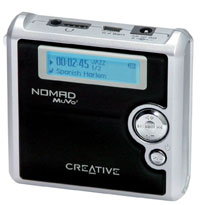
 First of all, space is cool from the perspective of a teenager, and there’s no worrying about how much tax payers money is put into these kind of projects. With this in mind, I was delighted to hear that the Shuttle
First of all, space is cool from the perspective of a teenager, and there’s no worrying about how much tax payers money is put into these kind of projects. With this in mind, I was delighted to hear that the Shuttle 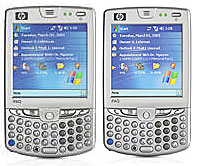 There were red faces at HP (or perhaps a wild cackle from a Machiavellian PR guru) after a video presentation on their website leaked details of their next smart-phone release, the iPaq hw6700 series.
There were red faces at HP (or perhaps a wild cackle from a Machiavellian PR guru) after a video presentation on their website leaked details of their next smart-phone release, the iPaq hw6700 series.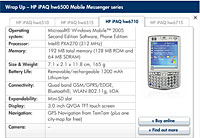 Both iPaqs come with a 3 inch, QVGA 240 x 320 pixel screen, with the handhelds measuring 7.1 x 2.1 x 11.8cm and weighing 165g. Power comes in the shape of a removable 1200mAh Lithium Ion battery
Both iPaqs come with a 3 inch, QVGA 240 x 320 pixel screen, with the handhelds measuring 7.1 x 2.1 x 11.8cm and weighing 165g. Power comes in the shape of a removable 1200mAh Lithium Ion battery Of course, it’s always wise to be wary when information is leaked in this manner, and there is something that doesn’t quite sit right in the presentation.
Of course, it’s always wise to be wary when information is leaked in this manner, and there is something that doesn’t quite sit right in the presentation. HTC are rumoured to have won the contract to manufacture the much-hyped Windows Mobile-based version of Palm’s Treo smart phone.
HTC are rumoured to have won the contract to manufacture the much-hyped Windows Mobile-based version of Palm’s Treo smart phone.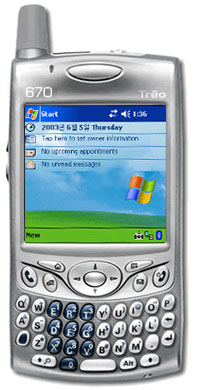 The Taiwan-based High Tech Computer (HTC) firm already manufactures its own popular suite of Windows Mobile-based smart phones and PDA-style communicators, which go under a mass of different names worldwide, depending on the mobile networks operators and handset vendors.
The Taiwan-based High Tech Computer (HTC) firm already manufactures its own popular suite of Windows Mobile-based smart phones and PDA-style communicators, which go under a mass of different names worldwide, depending on the mobile networks operators and handset vendors. Just as we went to press, another rumour flashed across the Web, with Cool Tech Times showing a fairly convincing photograph of what it reckons is the new Treo 700.
Just as we went to press, another rumour flashed across the Web, with Cool Tech Times showing a fairly convincing photograph of what it reckons is the new Treo 700. Viacom have announced that they will be launching a special super-spoddy edition Star Trek Communicator Phone, in association with Sona Mobile.
Viacom have announced that they will be launching a special super-spoddy edition Star Trek Communicator Phone, in association with Sona Mobile.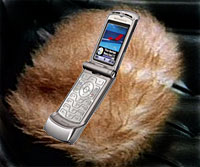 We couldn’t find a picture of the actual phone anywhere, although one poster on a Star Trek site claimed it was a re-branded Motorola V3 phone, while another frothed enthusiastically about a “multiplayer, persistent game universe, that uses location based / GPS information to alert you when an ‘enemy player’ is within range so you can do battle!”
We couldn’t find a picture of the actual phone anywhere, although one poster on a Star Trek site claimed it was a re-branded Motorola V3 phone, while another frothed enthusiastically about a “multiplayer, persistent game universe, that uses location based / GPS information to alert you when an ‘enemy player’ is within range so you can do battle!” AOL is giving away hundreds of thousands of dollars of gold, cash and goods seized from a spammer as a warning to anyone thinking of “making a living sending spam to AOL members”.
AOL is giving away hundreds of thousands of dollars of gold, cash and goods seized from a spammer as a warning to anyone thinking of “making a living sending spam to AOL members”. The company said it managed to close down the dastardly spammer’s 40-computer enterprise thanks to help from its members, who enthusiastically clicked a “report spam button” to register their complaints.
The company said it managed to close down the dastardly spammer’s 40-computer enterprise thanks to help from its members, who enthusiastically clicked a “report spam button” to register their complaints. Thanks to its aggressive mo’fo’ antispam filters, AOL has claimed that spam on their servers has fallen by more than 85 percent since its peak in late 2003.
Thanks to its aggressive mo’fo’ antispam filters, AOL has claimed that spam on their servers has fallen by more than 85 percent since its peak in late 2003.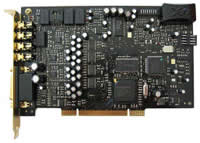 So what’s the deal here?
So what’s the deal here? Norwegian browser brewers, Opera Software, have announced Opera Mini, a J2ME (Java 2 Mobile Edition) Web browser for “virtually all mobile phones”.
Norwegian browser brewers, Opera Software, have announced Opera Mini, a J2ME (Java 2 Mobile Edition) Web browser for “virtually all mobile phones”. The browser makes up for the feeble firepower of low end phones by using a remote server to pre-process Web pages before sending them to the phone, rather than trying to get the phone to process the pages.
The browser makes up for the feeble firepower of low end phones by using a remote server to pre-process Web pages before sending them to the phone, rather than trying to get the phone to process the pages.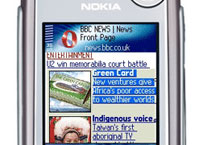 “With Opera Mini, the phone only has to run a small Java-client and the rest is taken care of by the remotely located Opera Mini server. With Opera Mini you don’t have to have an advanced phone to surf the Web, which means that most people can use it with their existing phones.”
“With Opera Mini, the phone only has to run a small Java-client and the rest is taken care of by the remotely located Opera Mini server. With Opera Mini you don’t have to have an advanced phone to surf the Web, which means that most people can use it with their existing phones.” Patriotically, Norway’s leading commercial television station, TV2, have already bundled Opera Mini with its mobile services in Norway to offer its viewers a complete mobile content package with a branded Web browser.
Patriotically, Norway’s leading commercial television station, TV2, have already bundled Opera Mini with its mobile services in Norway to offer its viewers a complete mobile content package with a branded Web browser. It used to be that artists rebelled against the system, the government, the breadheads and The Man, but artists signed to Sony in Japan are fighting their label’s decision not to make their songs available through the iTunes Music Store.
It used to be that artists rebelled against the system, the government, the breadheads and The Man, but artists signed to Sony in Japan are fighting their label’s decision not to make their songs available through the iTunes Music Store. Talks between the two electronic giants Sony and Apple are believed to be continuing to resolve the problem.
Talks between the two electronic giants Sony and Apple are believed to be continuing to resolve the problem. A couple of stories have been circulating about the BBC of late, both concerning their adoption of digital TV.
A couple of stories have been circulating about the BBC of late, both concerning their adoption of digital TV.